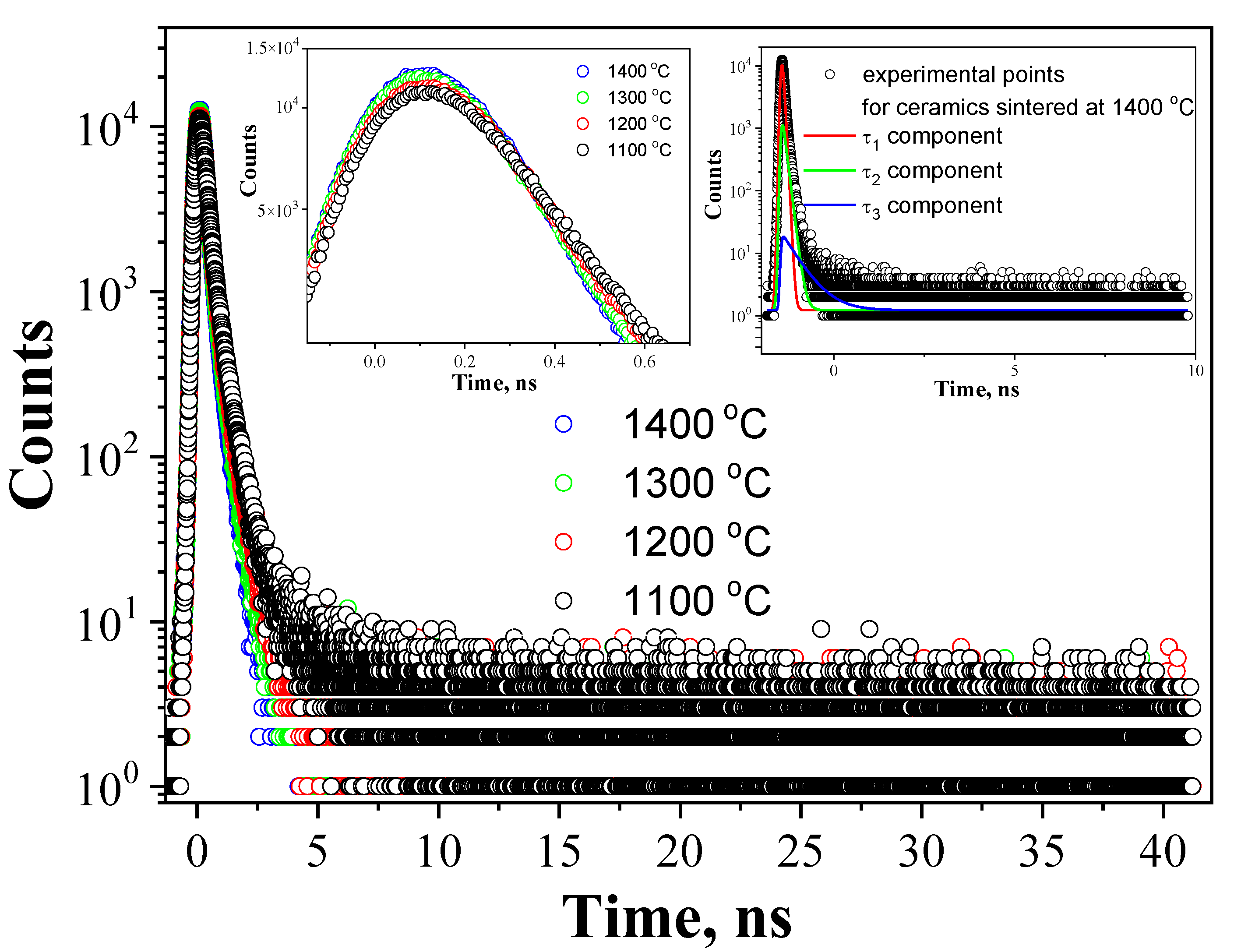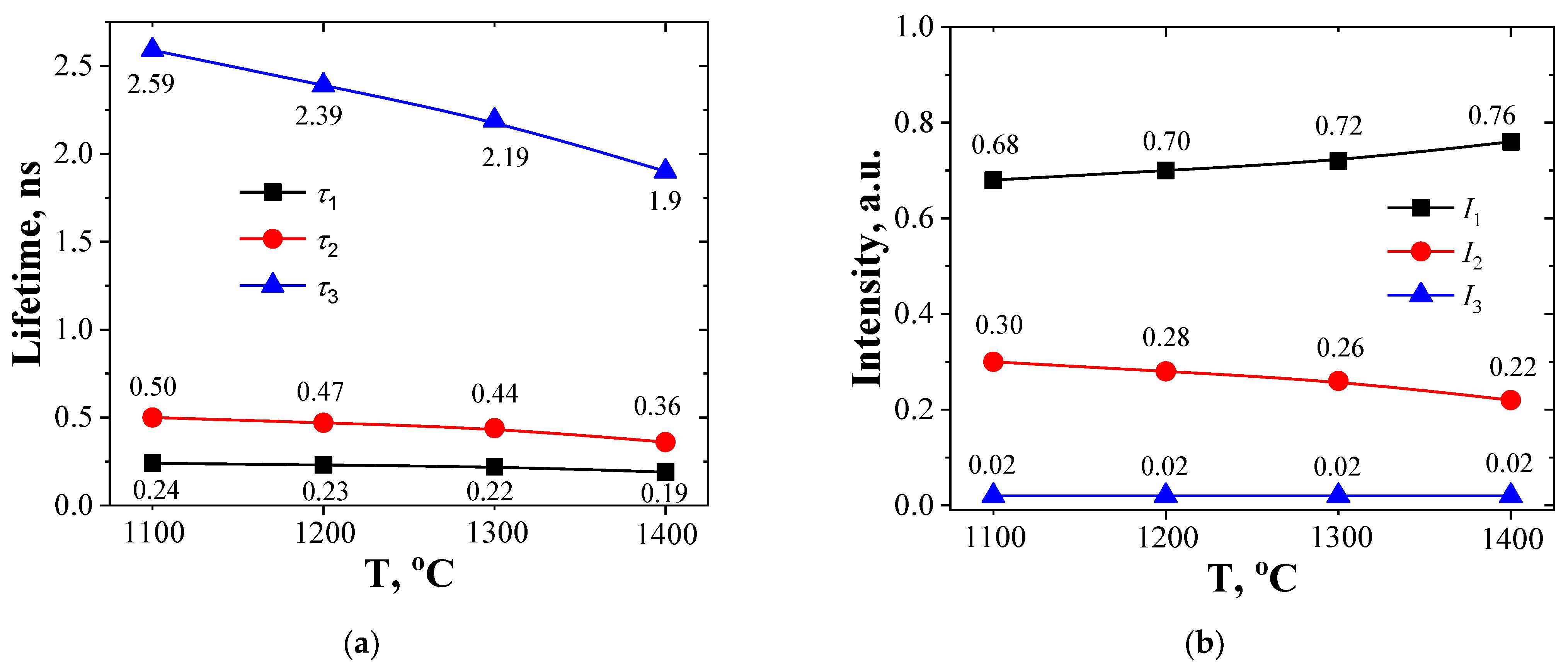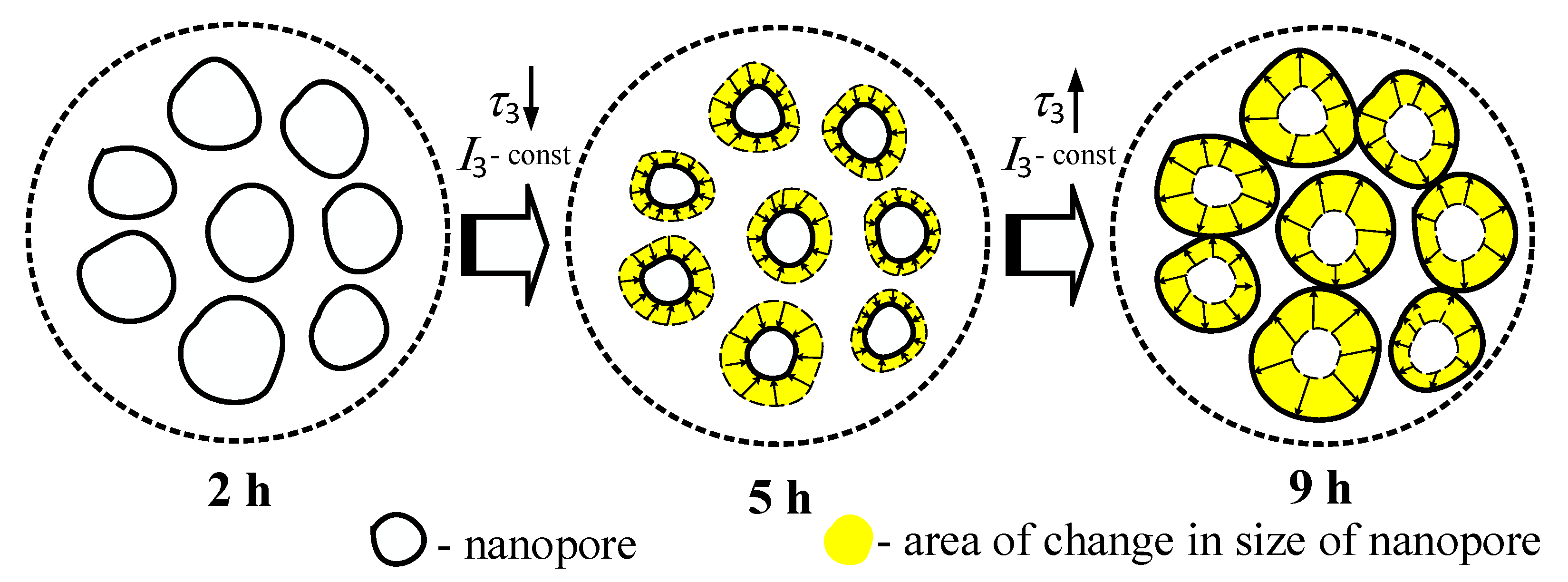Positron Annihilation Lifetime Spectroscopy Insight on Free Volume Conversion of Nanostructured MgAl2O4 Ceramics
Abstract
1. Introduction
2. Materials and Methods
3. Results and Discussion
4. Conclusions
Author Contributions
Funding
Data Availability Statement
Acknowledgments
Conflicts of Interest
References
- Pethrick, R.A. Positron annihilation—A probe for nanoscale voids and free volume? Prog. Polym. Sci. 1997, 22, 1–47. [Google Scholar] [CrossRef]
- Pereira, V.S.M.; Schut, H.; Sietsma, J. A study of the microstructural stability and defect evolution in an ODS Eurofer steel by means of Electron Microscopy and Positron Annihilation Spectroscopy. J. Nucl. Mater. 2020, 540, 152398. [Google Scholar] [CrossRef]
- Gholami, Y.H.; Yuan, H.; Wilks, M.Q.; Josephson, L.; el Fakhri, G.; Normandin, M.D.; Kuncic, Z. Positron annihilation localization by nanoscale magnetization. Sci. Rep. 2020, 10, 20262. [Google Scholar] [CrossRef] [PubMed]
- Zgardzińska, B.; Chołubek, G.; Jarosz, B.; Wysogląd, K.; Gorgol, M.; Goździuk, M.; Chołubek, M.; Jasińska, B. Studies on healthy and neoplastic tissues using positron annihilation lifetime spectroscopy and focused histopathological imaging. Sci. Rep. 2020, 10, 11890. [Google Scholar] [CrossRef]
- Rementeria, R.; Domínguez-Reyes, R.; Capdevila, C.; Garcia-Mateo, C.; Caballero, F.G. Positron Annihilation Spectroscopy Study of Carbon-Vacancy Interaction in Low-Temperature Bainite. Sci. Rep. 2020, 10, 487. [Google Scholar] [CrossRef]
- Dai, H.; Xie, X.; Chen, Z.; Ye, F.; Li, T.; Yang, Y. Microstructure evolution and magnetic properties of Eu doped CuFeO2 multiferroic ceramics studied by positron annihilation. Ceram. Int. 2018, 44, 13894–13900. [Google Scholar] [CrossRef]
- Bardyshev, I.I.; Gol’danskii, A.V.; Kotenev, V.A.; Tsivadze, A.Y. Positron Annihilation Spectroscopy for the Sintering of Boron Nitride Ceramics. Prot. Met. Phys. Chem. Surf. 2018, 54, 648–651. [Google Scholar] [CrossRef]
- Dai, H.Y.; Liu, H.Z.; Peng, K.; Ye, F.J.; Li, T.; Chen, J.; Chen, Z.P. Correlation between Vacancy Defects and Magnetic Properties of the GdMn1-xZnxO3 Multiferroic Ceramics Studied by Positron Annihilation. Mater. Res. Bull. 2019, 119, 110565. [Google Scholar] [CrossRef]
- Mohsen, M.; Gomaa, E.; Al-Kotb, M.S.; Abdel-Baki, M.; Fathy, N. Positron annihilation Lifetime and Fourier transform infrared spectroscopic studies on Bi2O3–B2O3 glasses. J. Non-Cryst. Solids 2016, 436, 1–8. [Google Scholar] [CrossRef]
- Zhao, Y.; Li, D.D.; Qu, B.Y.; Zhou, R.L.; Zhang, B.; Sato, K. Anomalous packing state in Ce-Ga-Cu bulk metallic glasses. Intermetallics 2017, 84, 25–29. [Google Scholar] [CrossRef]
- Li, J.; Wang, G.; Lin, C.; Zhang, T.; Zhang, R.; Huang, Z.; Shen, X.; Gu, B.; Ye, B.; Ying, F.; et al. Free-Volume Defects Investigation of GeS2-Ga2S3-CsI Chalcogenide Glasses by Positron Annihilation Spectroscopy. Infrared Phys. Technol. 2017, 83, 238–242. [Google Scholar] [CrossRef]
- Jean, Y.C.; Van Horn, J.D.; Hung, W.-S.; Lee, K.-R. Perspective of Positron Annihilation Spectroscopy in Polymers. Macromolecules 2013, 46, 7133–7145. [Google Scholar] [CrossRef]
- Sharma, S.K.; Pujari, P.K. Role of free volume characteristics of polymer matrix in bulk physical properties of polymer nanocomposites: A review of positron annihilation lifetime studies. Prog. Polym. Sci. 2017, 75, 31–47. [Google Scholar] [CrossRef]
- James, J.; Thomas, G.V.; Madathil, A.P.; Nambissan, P.M.G.; Kalarikkal, N.; Thomas, S. Positron annihilation spectroscopic characterization of free-volume defects and their correlations with the mechanical and transport properties of SBR–PMMA interpenetrating polymer networks. Phys. Chem. Chem. Phys. 2020, 22, 18169–18182. [Google Scholar] [CrossRef]
- Biswas, D.; Rajan, A.; Kabi, S.; Das, A.S.; Singh, L.S.; Nambissan, P.M.G. Structural defects characterization of silver-phosphate glass nanocomposites by positron annihilation and related experimental studies. Mater. Charact. 2019, 158, 109928. [Google Scholar] [CrossRef]
- Karbovnyk, I.; Collins, J.; Bolesta, I.; Stelmashchuk, A.; Kolkevych, A.; Velupillai, S.; Klym, H.; Fedyshyn, O.; Tymoshuk, S.; Kolych, I. Random nanostructured metallic films for environmental monitoring and optical sensing: Experimental and computational studies. Nanoscale Res. Lett. 2015, 10, 151. [Google Scholar] [CrossRef][Green Version]
- Kim, S.H.; Chung, J.W.; Kang, T.J.; Kwak, S.-Y.; Suzuki, T. Determination of the glass transition temperature of polymer/layered silicate nanocomposites from positron annihilation lifetime measurements. Polymer 2007, 48, 4271–4277. [Google Scholar] [CrossRef]
- Leipner, H.S.; Hübner, C.G.; Staab, T.E.M.; Haugk, M.; Krause-Rehberg, R. Positron Annihilation at Dislocations and Related Point Defects in Semiconductors. Phys. Status Solidi 1999, 171, 377–382. [Google Scholar] [CrossRef]
- Langhammer, H.T.; Müller, T.; Polity, A.; Felgner, K.-H.; Abicht, H.-P. On the crystal and defect structure of manganese-doped barium titanate ceramics. Mater. Lett. 1996, 26, 205–210. [Google Scholar] [CrossRef]
- Massoud, A.M.; Krause-Rehberg, R.; Langhammer, H.T.; Gebauer, J.; Mohsen, M. Defect Studies in BaTiO3 Ceramics Using Positron Annihilation Spectroscopy. Mater. Sci. Forum 2001, 363–365, 144–146. [Google Scholar] [CrossRef]
- Castro, M.S.; Salgueiro, W.; Somoza, A. Electron paramagnetic resonance and positron annihilation study of the compensation mechanisms in donor-doped ceramics. J. Phys. Chem. Solids 2007, 68, 1315–1323. [Google Scholar] [CrossRef]
- Zhi, Y.; Chen, A. A positron annihilation study of SrTiO3-based ceramics. J. Physics Condens. Matter 1993, 5, 1877–1882. [Google Scholar] [CrossRef]
- Selim, F.A.; Winarski, D.; Varney, C.R.; Tarun, M.C.; Ji, J.; McCluskey, M.D. Generation and characterization of point defects in SrTiO3 and Y3Al5O. Results Phys. 2015, 5, 28–31. [Google Scholar] [CrossRef]
- Banerjee, A.; Sarkar, A.; Sanyal, D.; Chatterjee, P.; Banerjee, D.; Chaudhuri, B.K. Positron annihilation lifetime studies on La0.5Pb0.5Mn1−yCryO. Solid State Commun. 2003, 125, 65–70. [Google Scholar] [CrossRef]
- Hassan, H.E.; Sharshar, T.; Hessien, M.M.; Hemeda, O.M. Effect of γ-rays irradiation on Mn–Ni ferrites: Structure, magnetic properties and positron annihilation studies. Nucl. Instrum. Methods Phys. Res. Sect. B Beam Interact. Mater. Atoms. 2013, 304, 72–79. [Google Scholar] [CrossRef]
- Maheshwari, P.; Keskar, N.; Sudarshan, K.; Manikrishna, K.V.; Krishnan, M.; Pujari, P.K. Investigating defect evolution during thermal treatment in Ni–Cr alloy using positron annihilation spectroscopy. J. Mater. Sci. 2020, 56, 3498–3509. [Google Scholar] [CrossRef]
- Wang, Z.; Dong, X.; Chen, Z.; Xiong, H.; Gao, J.; Du, J.; Tang, X.; Zhang, Q.; Qian, L.; Chen, Z. Dependence of the Ferromagnetism on Vacancy Defect in Annealed In 2 O 3 Nanocrystals: A Positron Annihilation Study. Phys. Status Solidi 2021, 218. [Google Scholar] [CrossRef]
- Ogorodnikova, O.V.; Majerle, M.; Čížek, J.; Simakov, S.; Gann, V.V.; Hruška, P.; Kameník, J.; Pospíšil, J.; Štefánik, M.; Vinš, M. Positron annihilation spectroscopy study of radiation-induced defects in W and Fe irradiated with neutrons with different spectra. Sci. Rep. 2020, 10, 18898. [Google Scholar] [CrossRef]
- Wang, Z.; Yang, Y.; Peng, X.; Huang, Z.; Qian, L.; He, C.; Fang, P. Water diffusivity transition in fumed silica-filled polydimethylsiloxane composite: Correlation with the interfacial free volumes characterized by positron annihilation lifetime spectroscopy. J. Mater. Sci. 2021, 56, 3095–3110. [Google Scholar] [CrossRef]
- El-Shaer, A.; Abdelfatah, M.; Mahmoud, K.R.; Momay, S.; Eraky, M.R. Correlation between photoluminescence and positron annihilation lifetime spectroscopy to characterize defects in calcined MgO nanoparticles as a first step to explain antibacterial activity. J. Alloys Compd. 2019, 817, 152799. [Google Scholar] [CrossRef]
- Ghosh, S.; Nambissan, P.M.G.; Bhattacharya, R. Positron annihilation and Mössbauer spectroscopic studies of In3+ substitution effects in bulk and nanocrystalline MgMn0.1Fe1.9−xInxO4. Phys. Lett. A 2004, 325, 301–308. [Google Scholar] [CrossRef]
- He, J.; Lin, L.-B.; Lu, T.-C.; Wang, P. Effects of electron- and/or gamma-irradiation upon the optical behavior of transparent MgAl2O4 ceramics: Different color centers induced by electron-beam and γ-ray. Nucl. Instrum. Methods Phys. Res. Sect. B Beam Interact. Mater. Atoms. 2002, 191, 596–599. [Google Scholar] [CrossRef]
- Nambissan, P.M.G.; Upadhyay, C.; Verma, H.C. Positron Lifetime Spectroscopic Studies of Nanocrystalline ZnFe2O4. J. Appl. Phys. 2003, 93, 6320. [Google Scholar] [CrossRef]
- Shantarovich, V.P. Positron annihilation and free volume studies in polymer glasses. J. Polym. Sci. Part B Polym. Phys. 2008, 46, 2485–2503. [Google Scholar] [CrossRef]
- Shpotyuk, O.; Calvez, L.; Petracovschi, E.; Klym, H.; Ingram, A.; Demchenko, P. Thermally-Induced Crystallization Behaviour of 80GeSe2–20Ga2Se3 Glass as Probed by Combined X-Ray Diffraction and PAL Spectroscopy. J. Alloys Compd. 2014, 582, 323–327. [Google Scholar] [CrossRef]
- Klym, H.; Ingram, A.; Shpotyuk, O.; Karbovnyk, I. Influence of CsCl Addition on the Nanostructured Voids and Optical Properties of 80GeS2-20Ga2S3 Glasses. Opt. Mater. 2016, 59, 39–42. [Google Scholar] [CrossRef]
- Klym, H.; Ingram, A.; Shpotyuk, O. Free-Volume Nanostructural Transformation in Crystallized GeS2-Ga2S3-CsCl Glasses. Mater. und Werkst. 2016, 47, 198–202. [Google Scholar] [CrossRef]
- Klym, H.; Ingram, A.; Shpotyuk, O.; Hotra, O.; Popov, A.I. Positron trapping defects in free-volume investigation of Ge–Ga–S–CsCl glasses. Radiat. Meas. 2016, 90, 117–121. [Google Scholar] [CrossRef]
- Klym, H.; Ingram, A.; Shpotyuk, O.; Szatanik, R. Free-Volume Study in GeS2-Ga2S3-CsCl Chalcohalide Glasses Using Positron Annihilation Technique. Phys. Procedia 2015, 76, 145–148. [Google Scholar] [CrossRef][Green Version]
- Klym, H.; Ingram, A.; Shpotyuk, O.; Hadzaman, I.; Solntsev, V. Water-Vapor Sorption Processes in Nanoporous MgO-Al2O3 Ceramics: The PAL Spectroscopy Study. Nanoscale Res. Lett. 2016, 11, 133. [Google Scholar] [CrossRef]
- Filipecki, J.; Ingram, A.; Klym, H.; Shpotyuk, O.; Vakiv, M. Water-sensitive positron trapping modes in nanoporous magnesium aluminate ceramics. J. Phys. Conf. Ser. 2007, 79, 012015. [Google Scholar] [CrossRef]
- Klym, H.; Hadzaman, I.; Shpotyuk, O. Influence of Sintering Temperature on Pore Structure and Electrical Properties of Technologically Modified MgO-Al2O3 Ceramics. Mater. Sci. 2015, 21, 92–95. [Google Scholar] [CrossRef]
- Karbovnyk, I.; Bolesta, I.; Rovetskii, I.; Velgosh, S.; Klym, H. Studies of CdI2-Bi3 microstructures with optical methods, atomic force microscopy and positron annihilation spectroscopy. Mater. Sci. 2014, 32, 391–395. [Google Scholar] [CrossRef]
- Klym, H.; Ingram, A. Unified model of multichannel positron annihilation in nanoporous magnesium aluminate ceramics. J. Phys. Conf. Ser. 2007, 79, 012014. [Google Scholar] [CrossRef]
- Krause-Rehberg, R.; Leipner, H.S. Positron Annihilation in Semiconductors: Defect Studies; Springer: Berlin/Heidelberg, Germany; New York, NY, USA, 1999. [Google Scholar]
- Kansy, J.; Giebel, D. Study of defect structure with new software for numerical analysis of PAL spectra. J. Phys. Conf. Ser. 2011, 265, 012030. [Google Scholar] [CrossRef]
- Klym, H.; Lukashevych, D. Multichannel Positron-Positronium Trapping Models for Nanovoids Characterization of Functional Materials. In Proceedings of the 2020 IEEE 40th International Conference on Electronics and Nanotechnology (ELNANO), Kyiv, Ukraine, 22–24 April 2020; pp. 272–275. [Google Scholar]
- Dupasquier, A.; De Natale, P.; Rolando, A. Formal calculation of the pick-off annihilation rate for ortho- and parapositronium. Phys. Rev. B 1991, 43, 10036–10041. [Google Scholar] [CrossRef]
- Goworek, T. Comments on the relation: Positronium lifetime–free volume size parameters of the Tao–Eldrup model. Chem. Phys. Lett. 2002, 366, 184–187. [Google Scholar] [CrossRef]
- Zaleski, R.; Wawryszczuk, J.; Goworek, T. Pick-off models in the studies of mesoporous silica MCM-Comparison of various methods of the PAL spectra analysis. Radiat. Phys. Chem. 2007, 76, 243–247. [Google Scholar] [CrossRef]
- Zgardzińska, B. The size of smallest subnanometric voids estimated by positron annihilation method. Correction to the Tao-Eldrup model. Chem. Phys. Lett. 2015, 622, 20–22. [Google Scholar] [CrossRef]
- Gorgol, M.; Maciejewska, M.; Jasińska, B.; Zaleski, R. Testing of the Extended Tao-Eldrup Model on Porous VP-DVB Copolymers. Mater. Sci. Forum 2012, 733, 24–28. [Google Scholar] [CrossRef]
- Seeman, V.; Feldbach, E.; Kärner, T.; Maaroos, A.; Mironova-Ulmane, N.; Popov, A.I.; Shablonin, E.; Vasil’chenko, E.; Lushchik, A. Fast-neutron-induced and as-grown structural defects in magnesium aluminate spinel crystals with different stoichiometry. Opt. Mater. 2019, 91, 42–49. [Google Scholar] [CrossRef]
- Lushchik, A.; Feldbach, E.; Kotomin, E.A.; Kudryavtseva, I.; Kuzovkov, V.N.; Popov, A.I.; Seeman, V.; Shablonin, E. Distinctive features of diffusion-controlled radiation defect recombination in stoichiometric magnesium aluminate spinel single crystals and transparent polycrystalline ceramics. Sci. Rep. 2020, 10, 7810. [Google Scholar] [CrossRef]
- Lushchik, A.; Dolgov, S.; Feldbach, E.; Pareja, R.; Popov, A.I.; Shablonin, E.; Seeman, V. Creation and thermal annealing of structural defects in neutron-irradiated MgAl2O4 single crystals. Nucl. Instrum. Methods Phys. Res. Sect. B Beam Interact. Mater. Atoms 2018, 435, 31–37. [Google Scholar] [CrossRef]
- Feldbach, E.; Museur, L.; Krasnenko, V.; Zerr, A.; Kitaura, M.; Kanaev, A. Defects induced by He+ irradiation in γ-Si3N4. J. Lumin. 2021, 237, 118132. [Google Scholar] [CrossRef]
- Feldbach, E.; Zerr, A.; Museur, L.; Kitaura, M.; Manthilake, G.; Tessier, F.; Krasnenko, V.; Kanaev, A. Electronic Band Transitions in γ-Ge3N4. Electron. Mater. Lett. 2021, 17, 315–323. [Google Scholar] [CrossRef]
- Kozlovskiy, A.; Kenzhina, I.; Alyamova, Z.; Zdorovets, M.V. Optical and structural properties of AlN ceramics irradiated with heavy ions. Opt. Mater. 2019, 91, 130–137. [Google Scholar] [CrossRef]
- Zdorovets, M.V.; Dukenbayev, K.; Kozlovskiy, A.L. Study of Helium Swelling in Nitride Ceramics at Different Irradiation Temperatures. Materials 2019, 12, 2415. [Google Scholar] [CrossRef]
- Kozlovskiy, A.; Kenzhina, I.; Dukenbayev, K.; Zdorovets, M. Influence of He-ion irradiation of ceramic AlN. Vacuum 2019, 163, 45–51. [Google Scholar] [CrossRef]
- Kurteeva, A.A.; Bogdanovich, N.M.; Bronin, D.I.; Porotnikova, N.M.; Vdovin, G.K.; Pankratov, A.A.; Beresnev, S.M.; Kuz’mina, L.A. Options for adjustment of microstructure and conductivity of cathodic substrates of La(Sr)MnO. Russ. J. Electrochem. 2010, 46, 811–819. [Google Scholar] [CrossRef]
- Porotnikova, N.M.; Eremin, V.A.; Farlenkov, A.S.; Kurumchin, E.K.; Sherstobitova, E.A.; Kochubey, D.I.; Ananyev, M.V. Effect of AO Segregation on Catalytical Activity of La0.7A0.3MnO3±δ (A = Ca, Sr, Ba) Regarding Oxygen Reduction Reaction. Catal. Lett. 2018, 148, 2839–2847. [Google Scholar] [CrossRef]
- Osinkin, D.A.; Khodimchuk, A.V.; Porotnikova, N.M.; Bogdanovich, N.M.; Fetisov, A.V.; Ananyev, M.V. Rate-Determining Steps of Oxygen Surface Exchange Kinetics on Sr2Fe1.5Mo0.5O6−δ. Energies 2020, 13, 250. [Google Scholar] [CrossRef]
- Suchikova, Y.O. Sulfide Passivation of Indium Phosphide Porous Surfaces. J. Nano-Electron. Phys. 2017, 9, 1006. [Google Scholar] [CrossRef]
- Suchikova, J.A. Synthesis of Indium Nitride Epitaxial Layers on a Substrate of Porous Indium Phosphide. J. Nano-Electron. Phys. 2015, 7, 03017. [Google Scholar]
- Kozlovskiy, A.; Shlimas, D.; Kenzhina, I.; Zdorovets, M. Study of the use of ionizing radiation to improve the efficiency of performance of nickel nanostructures as anodes of lithium-ion batteries. Mater. Res. Express 2019, 6, 055026. [Google Scholar] [CrossRef]
- Rumiantseva, Y.; Melnichuk, I.; Garashchenko, V.; Zaporozhets, O.; Turkevich, V.; Bushlya, V. Influence of cBN content, Al2O3 and Si3N4 additives and their morphology on microstructure, properties, and wear of PCBN with NbN binder. Ceram. Int. 2020, 46, 22230–22238. [Google Scholar] [CrossRef]
- Olenych, I.B.; Aksimentyeva, O.I.; Monastyrskii, L.S.; Horbenko, Y.Y.; Partyka, M.V. Electrical and Photoelectrical Properties of Reduced Graphene Oxide—Porous Silicon Nanostructures. Nanoscale Res. Lett. 2017, 12, 272. [Google Scholar] [CrossRef]






| Ts, °C | τav, ns | τb, ns | κd, ns−1 | τ2 − τb, ns | τ2/τb | R3, nm |
|---|---|---|---|---|---|---|
| 1100 | 0.32 | 0.28 | 0.65 | 0.21 | 1.72 | 0.338 |
| 1200 | 0.30 | 0.27 | 0.63 | 0.20 | 1.74 | 0.322 |
| 1300 | 0.27 | 0.25 | 0.62 | 0.19 | 1.74 | 0.305 |
| 1400 | 0.24 | 0.21 | 0.56 | 0.15 | 1.69 | 0.278 |
| Ts, °C/h | τ1, ns | I1, a.u. | τ2, ns | I2, a.u. | τ3, ns | I3, a.u. | τav, ns | τb, ns | κd, ns−1 | τ2 − τb, ns | τ2/τb | R3, nm |
|---|---|---|---|---|---|---|---|---|---|---|---|---|
| 1300/2 | 0.17 | 0.67 | 0.40 | 0.32 | 2.24 | 0.01 | 0.24 | 0.21 | 1.0 | 0.19 | 1.9 | 0.309 |
| 1300/5 | 0.16 | 0.71 | 0.38 | 0.28 | 2.17 | 0.01 | 0.22 | 0.19 | 1.0 | 0.19 | 2.0 | 0.303 |
| 1300/9 | 0.15 | 0.74 | 0.37 | 0.25 | 2.38 | 0.01 | 0.21 | 0.18 | 1.0 | 0.19 | 2.1 | 0.321 |
| 1400/2 | 0.16 | 0.78 | 0.38 | 0.21 | 2.18 | 0.01 | 0.20 | 0.18 | 0.9 | 0.20 | 2.1 | 0.304 |
| 1400/5 | 0.15 | 0.77 | 0.37 | 0.22 | 2.17 | 0.01 | 0.20 | 0.17 | 0.9 | 0.20 | 2.2 | 0.303 |
| 1400/9 | 0.15 | 0.77 | 0.37 | 0.22 | 1.83 | 0.01 | 0.20 | 0.17 | 0.9 | 0.20 | 2.2 | 0.271 |
Publisher’s Note: MDPI stays neutral with regard to jurisdictional claims in published maps and institutional affiliations. |
© 2021 by the authors. Licensee MDPI, Basel, Switzerland. This article is an open access article distributed under the terms and conditions of the Creative Commons Attribution (CC BY) license (https://creativecommons.org/licenses/by/4.0/).
Share and Cite
Klym, H.; Karbovnyk, I.; Piskunov, S.; Popov, A.I. Positron Annihilation Lifetime Spectroscopy Insight on Free Volume Conversion of Nanostructured MgAl2O4 Ceramics. Nanomaterials 2021, 11, 3373. https://doi.org/10.3390/nano11123373
Klym H, Karbovnyk I, Piskunov S, Popov AI. Positron Annihilation Lifetime Spectroscopy Insight on Free Volume Conversion of Nanostructured MgAl2O4 Ceramics. Nanomaterials. 2021; 11(12):3373. https://doi.org/10.3390/nano11123373
Chicago/Turabian StyleKlym, Halyna, Ivan Karbovnyk, Sergei Piskunov, and Anatoli I. Popov. 2021. "Positron Annihilation Lifetime Spectroscopy Insight on Free Volume Conversion of Nanostructured MgAl2O4 Ceramics" Nanomaterials 11, no. 12: 3373. https://doi.org/10.3390/nano11123373
APA StyleKlym, H., Karbovnyk, I., Piskunov, S., & Popov, A. I. (2021). Positron Annihilation Lifetime Spectroscopy Insight on Free Volume Conversion of Nanostructured MgAl2O4 Ceramics. Nanomaterials, 11(12), 3373. https://doi.org/10.3390/nano11123373







